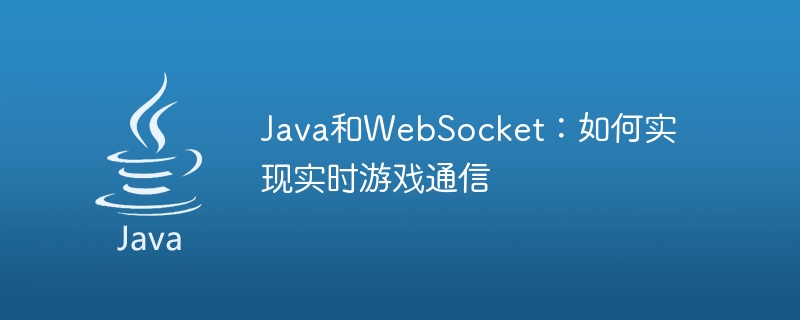Home >Java >javaTutorial >Java and WebSockets: How to implement real-time game communication
Java and WebSockets: How to implement real-time game communication
- WBOYWBOYWBOYWBOYWBOYWBOYWBOYWBOYWBOYWBOYWBOYWBOYWBOriginal
- 2023-12-17 22:24:561178browse

Java and WebSocket: Implementation of real-time game communication
Introduction:
With the development of the Internet and the popularity of smart devices, real-time game communication has become more and more important The more important it is. The traditional HTTP protocol has some limitations in realizing real-time communication, and WebSocket, as a full-duplex communication protocol, provides a better real-time communication solution. This article will introduce how to use Java and WebSocket to implement real-time game communication, with specific code examples.
1. Introduction to WebSocket
WebSocket is a protocol for full-duplex communication on a single TCP connection. Compared with the HTTP protocol, WebSocket can achieve real-time two-way communication and can pass smaller data packets between the client and the server. The WebSocket protocol uses a standard HTTP port to connect, allowing the client and server to establish a connection through a handshake, and once the connection is established, it can remain open.
2. Java implements WebSocket communication
Java has many libraries that support the WebSocket protocol, such as Java API for WebSocket, Jetty and Tyrus, etc. These libraries provide WebSocket-related classes and methods, which can help us easily implement WebSocket communication.
The following is a simple example using the Java API for WebSocket:
import javax.websocket.*;
import java.net.URI;
@ClientEndpoint
public class WebSocketClient {
Session session;
@OnOpen
public void onOpen(Session session) {
this.session = session;
}
@OnMessage
public void onMessage(String message) {
System.out.println("Received message: " + message);
}
@OnError
public void onError(Throwable t) {
t.printStackTrace();
}
@OnClose
public void onClose() {
System.out.println("Connection closed");
}
public void sendMessage(String message) {
session.getAsyncRemote().sendText(message);
}
public static void main(String[] args) throws Exception {
WebSocketContainer container = ContainerProvider.getWebSocketContainer();
String uri = "ws://localhost:8080/websocket";
container.connectToServer(WebSocketClient.class, URI.create(uri));
WebSocketClient client = new WebSocketClient();
client.sendMessage("Hello, server!");
Thread.sleep(5000);
client.session.close();
}
}In the above example, we created a WebSocketClient class and annotated it with the @ClientEndpoint annotation. This class defines methods such as onOpen, onMessage, onError and onClose, which respectively represent callback processing when the connection is established, a message is received, an error occurs and the connection is closed. The sendMessage method is used to send messages. In the main method, we first obtain the WebSocket container, then connect to the server through the connectToServer method, and use sendMessage to send the message. Finally, wait for 5 seconds and then close the connection through the Thread.sleep method.
3. Real-time Game Communication Example
In order to better understand how to use Java and WebSocket to achieve real-time game communication, we take a simple multiplayer game "Guessing Lantern Riddles" as an example.
-
Server-side code
import javax.websocket.*; import javax.websocket.server.ServerEndpoint; import java.io.IOException; import java.util.Collections; import java.util.HashSet; import java.util.Set; @ServerEndpoint("/websocket") public class WebSocketServer { private static Set<Session> sessions = Collections.synchronizedSet(new HashSet<>()); @OnOpen public void onOpen(Session session) { sessions.add(session); } @OnMessage public void onMessage(Session session, String message) throws IOException { for (Session s : sessions) { s.getBasicRemote().sendText(message); } } @OnClose public void onClose(Session session) { sessions.remove(session); } @OnError public void onError(Throwable t) { t.printStackTrace(); } }
In the above example, we created a WebSocketServer class and annotated it with the @ServerEndpoint annotation. This class defines methods such as onOpen, onMessage, onClose, and onError, which respectively represent callback processing when the connection is established, a message is received, the connection is closed, and an error occurs. In the onOpen method, we add the newly established connection to the sessions collection; in the onMessage method, we traverse the sessions collection and send the received messages to all clients; in the onClose method, we remove the closed connection from the sessions Removed from collection.
-
Client code
import javax.websocket.*; import java.io.IOException; import java.net.URI; import java.net.URISyntaxException; import java.util.Scanner; @ClientEndpoint public class WebSocketClient { Session session; @OnOpen public void onOpen(Session session) { this.session = session; } @OnMessage public void onMessage(String message) { System.out.println("Received message: " + message); } @OnError public void onError(Throwable t) { t.printStackTrace(); } @OnClose public void onClose() { System.out.println("Connection closed"); } public void sendMessage(String message) { try { session.getBasicRemote().sendText(message); } catch (IOException e) { e.printStackTrace(); } } public static void main(String[] args) throws URISyntaxException { WebSocketContainer container = ContainerProvider.getWebSocketContainer(); String uri = "ws://localhost:8080/websocket"; container.connectToServer(WebSocketClient.class, new URI(uri)); WebSocketClient client = new WebSocketClient(); System.out.println("Enter your message (type 'exit' to quit):"); Scanner scanner = new Scanner(System.in); while (true) { String input = scanner.nextLine(); if (input.equals("exit")) { break; } client.sendMessage(input); } client.session.close(); } }
In the above example, we created a WebSocketClient class and annotated it with the @ClientEndpoint annotation. This class defines methods such as onOpen, onMessage, onClose, and onError, which respectively represent callback processing when the connection is established, a message is received, the connection is closed, and an error occurs. The sendMessage method is used to send messages. In the main method, we first obtain the WebSocket container, then connect to the server through the connectToServer method, and use sendMessage to send messages entered from the keyboard. Finally, the user's input is continuously read through the scanner.nextLine method until "exit" is entered to exit.
Summary:
Through Java and WebSocket, we can easily achieve real-time game communication. Through the full-duplex communication feature of WebSocket, we can achieve two-way real-time communication between the client and the server, and can pass smaller data packets. In this article, we implement a simple real-time game communication example through the classes and methods provided by the Java API for WebSocket library. This example can be used as a learning and reference to help developers better understand and apply Java and WebSocket to achieve real-time game communication.
References:
- Java WebSocket Programming. https://www.baeldung.com/java-websockets
- Understanding WebSockets. https://www. ibm.com/support/knowledgecenter/en/SSEQTP_8.5.5/com.ibm.websphere.wsrp.doc/info/ae/ae/twbs_understand.html
(Note: The above code is only an example , may need to be modified and improved according to specific business needs.)
The above is the detailed content of Java and WebSockets: How to implement real-time game communication. For more information, please follow other related articles on the PHP Chinese website!

